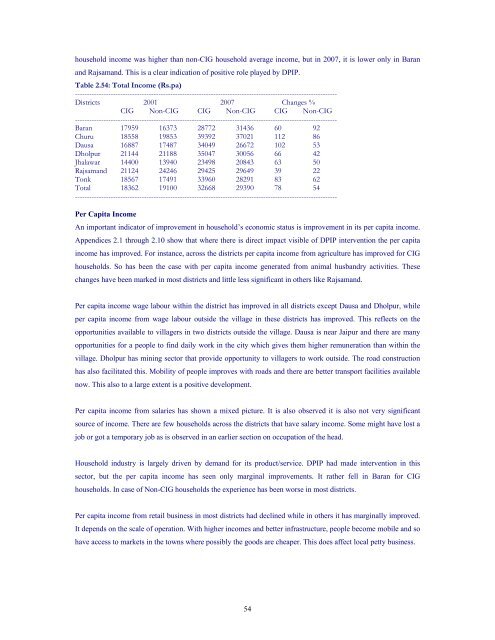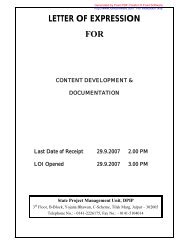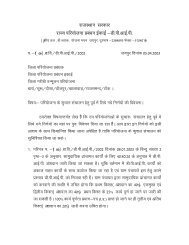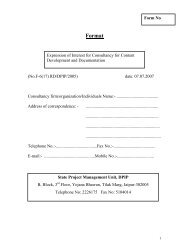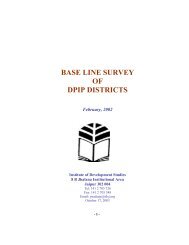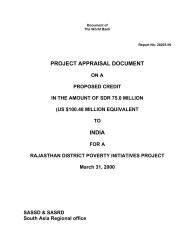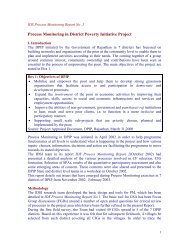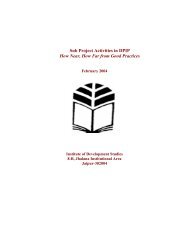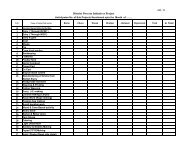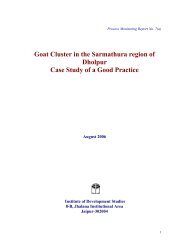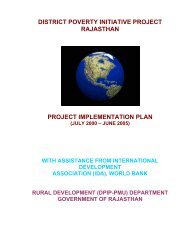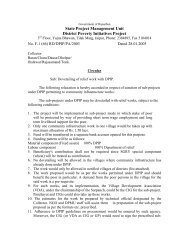Impact Assessment of the District Poverty Initiative Project Rajasthan
Impact Assessment of the District Poverty Initiative Project Rajasthan
Impact Assessment of the District Poverty Initiative Project Rajasthan
You also want an ePaper? Increase the reach of your titles
YUMPU automatically turns print PDFs into web optimized ePapers that Google loves.
household income was higher than non-CIG household average income, but in 2007, it is lower only in Baran<br />
and Rajsamand. This is a clear indication <strong>of</strong> positive role played by DPIP.<br />
Table 2.54: Total Income (Rs.pa)<br />
--------------------------------------------------------------------------------------------------------------<br />
<strong>District</strong>s 2001 2007 Changes %<br />
CIG Non-CIG CIG Non-CIG CIG Non-CIG<br />
--------------------------------------------------------------------------------------------------------------<br />
Baran 17959 16373 28772 31436 60 92<br />
Churu 18558 19853 39392 37021 112 86<br />
Dausa 16887 17487 34049 26672 102 53<br />
Dholpur 21144 21188 35047 30056 66 42<br />
Jhalawar 14400 13940 23498 20843 63 50<br />
Rajsamand 21124 24246 29425 29649 39 22<br />
Tonk 18567 17491 33960 28291 83 62<br />
Total 18362 19100 32668 29390 78 54<br />
--------------------------------------------------------------------------------------------------------------<br />
Per Capita Income<br />
An important indicator <strong>of</strong> improvement in household’s economic status is improvement in its per capita income.<br />
Appendices 2.1 through 2.10 show that where <strong>the</strong>re is direct impact visible <strong>of</strong> DPIP intervention <strong>the</strong> per capita<br />
income has improved. For instance, across <strong>the</strong> districts per capita income from agriculture has improved for CIG<br />
households. So has been <strong>the</strong> case with per capita income generated from animal husbandry activities. These<br />
changes have been marked in most districts and little less significant in o<strong>the</strong>rs like Rajsamand.<br />
Per capita income wage labour within <strong>the</strong> district has improved in all districts except Dausa and Dholpur, while<br />
per capita income from wage labour outside <strong>the</strong> village in <strong>the</strong>se districts has improved. This reflects on <strong>the</strong><br />
opportunities available to villagers in two districts outside <strong>the</strong> village. Dausa is near Jaipur and <strong>the</strong>re are many<br />
opportunities for a people to find daily work in <strong>the</strong> city which gives <strong>the</strong>m higher remuneration than within <strong>the</strong><br />
village. Dholpur has mining sector that provide opportunity to villagers to work outside. The road construction<br />
has also facilitated this. Mobility <strong>of</strong> people improves with roads and <strong>the</strong>re are better transport facilities available<br />
now. This also to a large extent is a positive development.<br />
Per capita income from salaries has shown a mixed picture. It is also observed it is also not very significant<br />
source <strong>of</strong> income. There are few households across <strong>the</strong> districts that have salary income. Some might have lost a<br />
job or got a temporary job as is observed in an earlier section on occupation <strong>of</strong> <strong>the</strong> head.<br />
Household industry is largely driven by demand for its product/service. DPIP had made intervention in this<br />
sector, but <strong>the</strong> per capita income has seen only marginal improvements. It ra<strong>the</strong>r fell in Baran for CIG<br />
households. In case <strong>of</strong> Non-CIG households <strong>the</strong> experience has been worse in most districts.<br />
Per capita income from retail business in most districts had declined while in o<strong>the</strong>rs it has marginally improved.<br />
It depends on <strong>the</strong> scale <strong>of</strong> operation. With higher incomes and better infrastructure, people become mobile and so<br />
have access to markets in <strong>the</strong> towns where possibly <strong>the</strong> goods are cheaper. This does affect local petty business.<br />
54


